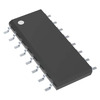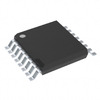Manufacturer Part Number
TL1451CNSR
Manufacturer
Texas Instruments
Introduction
The TL1451CNSR is a versatile power management integrated circuit designed for DC-DC switching controller applications.
Product Features and Performance
Dual-channel operation suitable for step-up, step-down, and step-up/step-down configurations
Positive output configuration supporting multiple topologies including Buck, Boost, and Flyback
Operates across a wide voltage supply range from 3.6V to 50V
Adjustable switching frequency from 1kHz to 500kHz
Surface mount 16-SOIC packaging offering compact footprint
Product Advantages
Versatility in supporting various circuit topologies
High-frequency operation enabling smaller passive components
Broad voltage supply range catering to a wide variety of power sources
Dual outputs for managing multiple power rails with one device
Key Technical Parameters
Output type: Transistor Driver
Number of outputs: 2
Output phases: 1
Voltage - Supply: 3.6V ~ 50V
Frequency - Switching: 1kHz ~ 500kHz
Operating Temperature: -20°C ~ 85°C
Quality and Safety Features
Designed to meet stringent industry standards for quality and reliability
Operational temperature range ensures stability across various environmental conditions
Compatibility
Compatible with various types and sizes of external components
Support for surface mount technology aligns with modern PCB assembly processes
Application Areas
Power supplies for consumer electronics
Industrial control systems
Telecommunication equipment
Automotive electronics
Product Lifecycle
Status: Active
Not currently nearing discontinuation
Potential future availability of replacements or upgrades
Several Key Reasons to Choose This Product
Customizable switching frequency permitting design flexibility
High voltage supply range making it suitable for diverse applications
Integrated features such as frequency control minimize the need for external components
Industry-renowned manufacturer Texas Instruments ensures reliability and performance
Dual-channel controller increases system design efficiency





 TL1451AQPWRQTexas Instruments
TL1451AQPWRQTexas Instruments TL1451AQPWRQ1Texas InstrumentsIC REG CTRLR MULT TOP 16TSSOP
TL1451AQPWRQ1Texas InstrumentsIC REG CTRLR MULT TOP 16TSSOP TL1451CDBRTexas InstrumentsIC REG CTRLR MULT TOP 16SSOP
TL1451CDBRTexas InstrumentsIC REG CTRLR MULT TOP 16SSOP